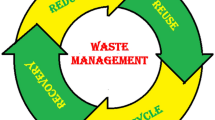Abstract
The environmental behavior, biological and ecological effects of nanomaterial have attracted much attention, and nanomaterial is prevalently used in the process of industrial manufacturing. However, the investigation on how to resolve the environmental problems of nanowastes is scarcely reported. We have proposed a novel method in which the toxicity of the waste is reduced during the fast growth of nanoparticals. It is suggested that this method could be used in the treatment of the Cr(VI)-containing nanowastes from the chlorate plants. In this work, the efficiencies of the treatment at both room and high temperatures were further studied. The craft route is advanced for the treatment at the high temperature. The phase, morphology, size, and thermal behavior of the detoxified solid were analyzed by XRD, SEM, and DTA. The solid was also tried as the raw of glaze. The disposal provided here will be a good example for the recycling of the hazardous nanowastes.
Similar content being viewed by others
References
Gupta A K, Gupta M. Synthesis and surface engineering of iron oxide nanoparticles for biomedical applications. Biomaterials, 2005, 26: 3995–4021
Chen X, Schluesener H J. Nanosilver: A nanoproduct in medical application. Toxicol Lett, 2008, 176: 1–12
Ponder S M, Darab J G, Mallouk T E. Remediation of Cr(VI) and Pb(II) aqueous solutions using supported, nanoscale zero-valent iron. Environ Sci Technol, 2000, 34: 2564–2569
Huang S H, Chen D H. Rapid removal of heavy metal cations and anions from aqueous solutions by an amino-functionalized magnetic nano-adsorbent. J Hazard Mater, 2009, 163: 174–179
Mauter M S, Elimelech M. Environmental applications of carbon-based nanomaterials. Environ Sci Technol, 2008, 42: 5843–5859
Pouretedal H R, Norozi A, Keshavarz M H, et al. Nanoparticles of zinc sulfide doped with manganese, nickel and copper as nanophotocatalyst in the degradation of organic dyes. J Hazard Mater, 2009, 162: 674–681
Hardman R. A toxicologic review of quantum dots: Toxicity depends on physicochemical and environmental factors. Environ Health Persp, 2006, 114: 165–172
Singh S, Nalwa H S. Nanotechnology and health safety-Toxicity and risk assessments of nanostructured materials on human health. J Nanosci Nanotechno, 2007, 7: 3048–3070
Suzuki Y, Kelly S D, Kemner K M, et al. Radionuclide contamination-nanometre-size products of uranium bioreduction. Nature, 2002, 419: 134
Tang H X. Environmental Nano-Pollutants (ENP) and their microinterfacial processes on the aquatic particles. Acta Sci Circum, 2003, 32: 146–155
Hassellov M, Readman J W, Ranville J F, et al. Nanoparticle analysis and characterization methodologies in environmental risk assessment of engineered nanoparticles. Ecotoxicology, 2008, 17: 344–361
Christian P, von der Kammer F, Baalousha M, et al. Nanoparticles: Structure, properties, preparation and behaviour in environmental media. Ecotoxicology, 2008, 17: 326–343. doi: 10.1007/s10646- 008-0213-1
Huang S H, Chen C C. Ultrafine aerosol penetration through electrostatic precipitators. Environ Sci Technol, 2002, 36: 4625–4632
Holmen B A, Ayala A. Ultrafine PM emissions from natural gas, oxidation- catalyst diesel, and particle-trap diesel heavy-duty transit buses. Environ Sci Technol, 2002, 36: 5041–5050
Morawska L, Thomas S, Gilbert D, et al. A study of the horizontal and vertical profile of submicrometer particles in relation to a busy road. Atmos Environ, 1999, 33: 1261–1274
Liu W Z, Huang F, Liao Y Q, et al. Treatment of Cr-VI-containing Mg(OH)2 nanowaste. Angew Chem Int Edit, 2008, 47: 5619–5622
Moon D H, Wazne M, Dermatas D, et al. Long-term treatment issues with chromite ore processing residue (COPR): Cr6+ reduction and heave. J Hazard Mater, 2007, 143: 629–635
Huang F, Zhang H Z, Banfield J F. Two-stage crystal-growth kinetics observed during hydrothermal coarsening of nanocrystalline ZnS. Nano Lett, 2003, 3: 373–378
Zhang J, Lin Z, Lan Y Z, et al. A multistep oriented attachment kinetics: Coarsening of ZnS nanoparticle in concentrated NaOH. J Am Chem Soc, 2006, 128: 12981–12987
Zhang J, Wang Y H, Zheng J S, et al. Oriented attachment kinetics for ligand capped nanocrystals: Coarsening of thiol-PbS nanoparticles. J Phys Chem B, 2007, 111: 1449–1454
Author information
Authors and Affiliations
Corresponding author
About this article
Cite this article
Liu, W., Xu, X., Wang, Y. et al. Treatment of Cr(VI)-containing nanowastes via the growth of nanomaterial. Chin. Sci. Bull. 55, 373–377 (2010). https://doi.org/10.1007/s11434-009-0716-z
Received:
Accepted:
Published:
Issue Date:
DOI: https://doi.org/10.1007/s11434-009-0716-z




